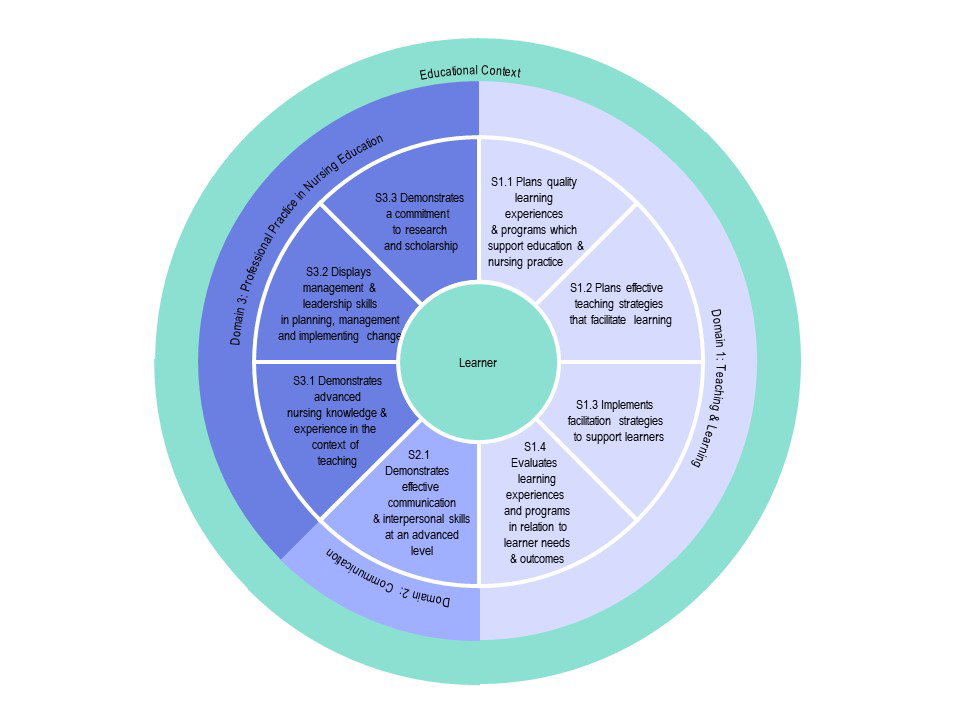Purpose of the Standards
The Australian Nurse Teachers’ Society (ANTS) is pleased to announce the release of the 2024 Australian Nursing Educator Professional Practice Standards (the ‘Standards’).
The Standards offer nursing educators a comprehensive framework for educational practice applicable across various educational settings, including clinical settings or academia, and at all levels of educator experience. The Standards’ framework guides nursing educators' best practices and is adaptable to the practitioner’s educational context.
Key Definitions
A nursing educator is a registered nurse or midwife who engages in the education of nurses. Settings refer to the various environments where educational practices are applied. Examples include universities, hospitals, education companies such as Ausmed Education, simulation laboratories, and the community. In this context, learners refer to individuals engaging in educational activities representing a spectrum of experiences and backgrounds. Examples include undergraduate students, newly graduated registered nurses, hospital staff, and patients or clients. Each type of learner brings distinct needs and perspectives to the educational environment.
Structure of the Standards
The Standards are organised into three major domains, as seen in the figure below. They are:
- Domain 1 - Teaching and Learning
- Domain 2 - Communication
- Domain 3 - Professional Practice

3 Major Domains
For each statement within these domains, cues or examples offer context and enhance understanding. These cues are illustrative rather than comprehensive or universally applicable, clarifying the Standards without being exhaustive or definitive.
Domain 1 - Teaching and Learning
The core role of the nursing educator is to facilitate learning. Within this domain, there are four Standards. They are organised using a best-practice approach to plan, implement, and evaluate.
- 1.1 Plans quality learning experiences and programs that support education and nursing practice
- 1.2 Plans effective teaching strategies that facilitate learning
- 1.3 Implements facilitation strategies to support learners
- 1.4 Evaluates learning experiences and programs in relation to learner needs and learning outcomes
Domain 2 - Communication
Educators must possess strong communication skills across all facets of educational practice. There is one Standard within this domain: 2.1 Demonstrates effective communication and interpersonal skills at an advanced level. This encompasses critical skills, including respecting all participants, collaborating with health professionals, employing advanced communication and digital skills, and using online learning applications, such as a Learning Management System (LMS), to enhance teaching effectiveness.
Domain 3 - Professional Practice in Nursing Education
Educators must show advanced professional practice in nursing education, including expertise in instructional methodologies, educational management and leadership capabilities, and a dedication to research and scholarly activities tailored to their specific educational context. Three associated Standards support this requirement. They are:
- 3.1 - Demonstrates advanced nursing knowledge and expertise in the context of teaching
- 3.2 - Displays management and leadership skills in planning, managing and implementing change
- 3.3 - Demonstrates a commitment to research and scholarship
How were the Standards Developed?
ANTS is an organisation that represents nursing and midwifery educators in any practice setting. It supports and encourages the development of excellence in nursing and midwifery education. ANTS originally developed nurse teacher competencies in 1997, later revised in 2010. Dr Jacquie Guy, President of ANTS, then led the 2010 review, which involved conducting a Delphi research study. A Delphi study consists of a series of surveys that panel members complete independently, with the researchers aiming for a consensus of agreement on the survey items. In 2014, the word ‘competencies’ was replaced by ‘professional Standards’ in the title to reflect the discourse where the term ‘competencies’ was thought too restrictive when describing professional roles.
Review Process
As it was over ten years since the Standards were last reviewed, ANTS decided to review the 2010 Standards to see if they were still relevant to nursing educator practice. Dr Christine Taylor and the ANTS National Committee led the team. The team undertook a research project that received ethical approval from Western Sydney University, which included conducting a Delphi study and focus groups. Expert nursing educators from various settings, such as academia, clinical, and professional organisations, received invitations to participate in the expert panel, while nursing educators joined the focus groups.
Results
Overall, the results showed high agreement for all statements in the first survey, which reflected that the Standards were still relevant today. However, comments from the surveys and focus groups suggested some changes could be made, such as modifying terminology, rewording statements, and adding additional concepts. There was also a suggestion that the Standards needed some context around the statements.
Significant Changes from 2010
The Project Team changed the title and used the term "nursing educator" instead of "nurse teacher" to reflect the comprehensive nature of the Standards. They avoided using the term 'nurse educator' because some states have 'nurse educator' classifications for employment, which could confuse if used. The Project Team added several statements to clarify concepts, such as indicating that research should underpin educational practice and demonstrating knowledge and expertise in academic practice. They also introduced sustainability as a new concept in the Standards.
The Standards include cues or examples to provide context for each statement. For instance, cues help describe sustainability as a broad concept that could include the sustainability of educational resources or equitable access. The cues are not exhaustive and broadly apply to various situations and academic contexts.
Applying the Standards
The Standards were developed for all nursing educators, regardless of the setting in which they work, their role, or their level of experience in nursing education. When applying the Standards, educators, managers, and policymakers should consider the educational context of the nursing educator and apply those relevant to the individual practice context. We encourage you to use the 2024 Standards as a framework for educational practice. It can guide individual educational training and inform policy and processes, educator evaluation, and curricula.
Practical Application of Standard 1.1.6
Standard 1.1.6 from the Learning and Teaching Domain offers a robust framework for nurse educators to assess and enhance the learning environment, aligning with their learners' needs. This Standard emphasises the importance of evaluating the learning setting through evidence-based practices, employing formal and informal evaluation methods, and fostering a supportive atmosphere conducive to learning.
Example - Reflective Practice
Nurse educators can utilise this Standard as a tool for reflective practice by assessing their effectiveness in evaluating and improving the learning environment. Questions to consider might include the following:
- How well am I performing these evaluations?
- What gaps exist in my knowledge or skills?
- What are the best ways to enhance my understanding or abilities in this area?
- Does that constitute an explicit learning need that I can address via engaging in CPD?
Example - Position Descriptions and Policy Implementation
This Standard also serves practical purposes when nurse educators must develop or revise position descriptions or write and review policies and procedures. It helps articulate educators' specific roles and responsibilities in maintaining and enhancing the educational setting, ensuring that all activities align with best practices in nursing education.
By integrating Standard 1.1.6 into practice, nurse educators reinforce their commitment to quality educational outcomes and contribute to a culture of continuous improvement and professional excellence within their institutions.
The Project Team
Ausmed Education is proud to share the 2024 Australian Nursing Educator Professional Practice Standards, developed by an esteemed Project Team led by Dr. Christine Taylor, with Assoc. Prof. Julie Shaw, Ms Creina Mitchell, Ms Hellen Kaneko, and Ms Belinda Foley. We thank the Project Team for their dedication and expertise in shaping these Standards for the broader education and learning development workforce.
International Equivalent
These Australian Standards complement the international version titled "Nursing Professional Development: Scope and Standards of Practice, 4th Ed. (2022)." The NPD Scope and Standards of Practice serve as a foundational document that elaborates on the NPD practice's who, what, when, where, how, and where. We encourage nurse educators, L&D professionals, and others working in professional development to review these essential Standards.
Author
Dr Christine Taylor
Dr Christine Taylor is an Adjunct Fellow in the School of Nursing and Midwifery at Western Sydney University and a core member of The New South Wales Centre for Evidence-Based Health Care, which supports nurses in systematic reviews and implementation reports. Christine is an experienced educator, having spent over 25 years in higher education in various roles, such as Director of Clinical Education, coordinating subjects, teaching, and developing curricula and subjects.
Christine has supervised PhD and Honours students and has published in nursing education and child and family health. Christine’s educational practice was underpinned by a wide variety of clinical experiences extending over 30 years, including adult and paediatric nursing. Christine has been a long-time supporter and is a Life Member of the Australian Nurse Teachers’ Society, and served on the Executive committee for several terms.



